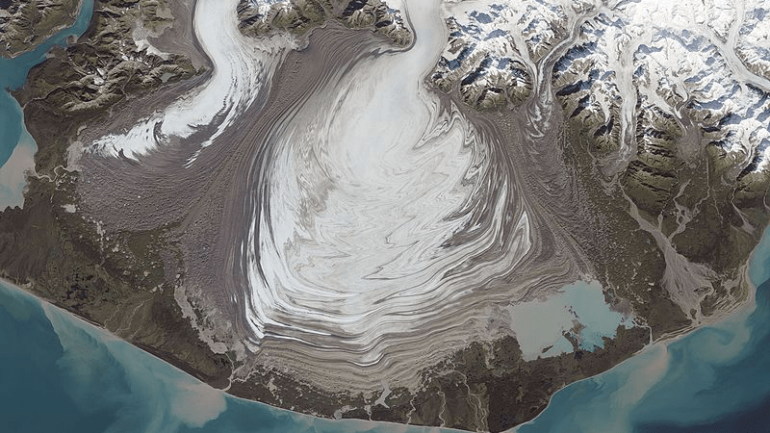Understanding the surges and retreats of Alaska’s Malaspina Glacier is key if climate change models are to be applied to the glacier with confidence. Work by graduate student Victor Devaux-Chupin at the University of Alaska Fairbanks Geophysical Institute is providing some answers.
The Malaspina consists of three lobes, each fed by its own glacier. The Agassiz glacier becomes the Malaspina’s western lobe, the Seward glacier forms the center lobe, and the Marvine glacier is the eastern lobe.
Devaux-Chupin’s analysis of data from 1984 to this year shows the Malaspina surges approximately every 10 years, principally from the central lobe, which is the largest.
The glacier is surging once again, and the central lobe is leading the way.
“Our goal is to be able to model the glacier to put simulations of climate change on it to assess how much it might melt and retreat over the coming decades,” said, Devaux-Chupin, who is working under guidance of physics professor Martin Truffer of the Geophysical Institute’s Snow, Ice and Permafrost Group. “To do that, we need to understand it. And one of the first steps is to look at it from satellite images to understand how it flows.”
He has divided the glacier into zones based on ice velocity, direction and tributary glacier of origin, and has also identified potential local triggers that could lead to the glacier’s retreat.
Study of the glacier is important for climate change analysis because the Malaspina is the world’s largest piedmont glacier, a type of glacier in which the flow spills from a narrow valley into a flat plain and spreads out like a fan.
Malaspina Glacier covers about 1,500 square miles and is easily accessible to researchers. Many other piedmont glaciers are in Antarctica and Greenland and not readily accessible.
“And the Malaspina is flowing much faster than the piedmont glaciers in Antarctica and Greenland, which are mostly cold and don’t move as much,” he said. “So that provides us with more insight.”
One of the notable things, which prompted Devaux-Chupin’s research, is the presence of lakes—called proglacial lakes because of their immediate proximity to a glacier—close to the shoreline that are rapidly advancing into the glacier. At least one lake contains seawater, and scientists know that access to the ocean increases the rate of a glacier’s retreat.
Much of Malaspina Glacier is below sea level, meaning an advancing proglacial lake of seawater could be carving a path for the ocean to enter the depression left when the glacier eventually retreats.
“What it means is that it’s really a sitting duck for climate change,” Devaux-Chupin said.
And that has implications for the landscape, for the local ecosystem and for the local population and businesses. The glacier is just 38 miles across Yakutat Bay from the city of Yakutat and is located mostly in Wrangell-St. Elias National Park and Preserve. Yakutat residents use land in front of the Malaspina Glacier for hunting and recreation, and some tour businesses operate in the area.
More information:
Devaux-Chupin’s abstract is here.
Provided by
University of Alaska Fairbanks
Citation:
Malaspina Glacier, world’s largest piedmont glacier, surges approximately every 10 years (2022, January 5)



